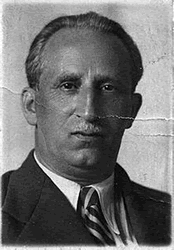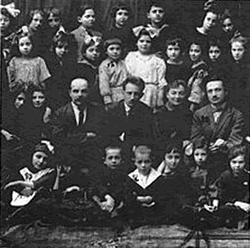Born
(1884-12-30)December 30, 1884
Neishtate Kybartai, Lithuania
Died
December 29, 1944(1944-12-29) (aged 59)
Dautmergen-Schömberg, (Natzweiler-Struthof), Germany
Occupation
Educator
Employer
Hebrew Reali Gymnasium
Spouse(s)
Elke Freida (née Buzhanski)
Tzemach Ben Zvi Feldstein [t?????? f?ldstajn] - (Lithuanian: Feldsteinas -Russian: Semyon Grigorovitch – Hebrew (??? ????????) December 30, 1884 - December 29, 1944[1] was a Jewish Lithuanian, an author, an education reformist and a culture activist, and a Zionist. As an educator he was appointed the director of several Jewish gymnasiums. The most notable was the Hebrew Reali Gymnasium (Ha Riealy Ha Ivri) in Kovno (Kaunas) Lithuania, from 1922-1940 where he implemented the system of using Modern Hebrew when teaching Jewish subjects.
Even when deported to the Vilna Ghetto in 1941, Dr. Feldstein continued to be a Jewish cultural activist. He became the editor of the ghetto newspaper, translated essays and writings into Hebrew, gave lectures, and was an inspirational coordinator the ghetto's cultural life.
Dr. Feldstein with the pupils and faculty of the Hebrew Realgymnasium circa 1920’s
Tzemach Ben Zvi Feldstein was born in the town of Neishtate Kybartai, in Southwestern Lithuania on 30 December 1884.[2] He was the eldest of five children, two boys and three girls. His father was Zvi Feldstein, an Jewish orthodox merchant. His mother was Malka Leah. Dr. Feldstein studied in several schools and graduated from a Gymnasium in Königsberg, East Prussia, Germany. He then enrolled at the University of Berlin in Germany where he studied history and philosophy. After finishing his first degree, Dr. Feldstein continued his education at the University of Bern in Switzerland where he received a doctoral degree. His dissertation was on Hermann Cohen’s interpretation of Kant’s Foundations of Ethics. Ludwig Stein guided him through the dissertation process. Dr. Feldstein submitted his dissertation in November 1907 and it was published in Tzarist Russia (Breslau, Poland) in 1914. During his studies at Bern, he met his future wife, Elke Freida Buzansky, who was close to finishing her medical studies. She gave up completing her degree to marry him in 1910. The couple moved to Warsaw, Poland where he became a teacher of Hebrew culture at the Magnus Krinsky Jewish Gymnasium. The couple had three children: Araeh Leib (Liova - b. 1911), Esther (Toussia - b. 1914), and Joshua (Yehoshua - b. 1921).
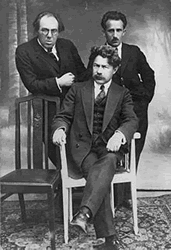
Nathan Goren, Shaul Tchernichovsky and Tzemach Feldstein in Kaunas,1927
Career
In 1913, Dr. Feldstein served as the first director of the bilingual Jewish Gymnasium founded in Kalisz, Poland. During the First World War, he and his wife moved to Minsk, Russia where he founded and directed a private Gymnasium. His wife taught mathematics and Russian literature at the school.
Dr. Feldstein and his family returned to Lithuania after World War I and after the establishment of the first Lithuanian Republic. From 1921-1922 he served as the director of the Hebrew Gymnasium, founded in 1919, in Vilkaviskis, Lithuania.[3] Under his guidance, all Hebrew subjects taught used Sephardic diction (the same method used in the New Yishuv in British Palestine).
In 1922, Dr. Feldstein went to the de facto capital, Kaunas, of Lithuania to replace Dr. Shalom Yona Tscherna, as the principal of the Hebrew Reali Gymnasium (Jüdische Realgymnasium), founded by the Jewish-German Rabbi, Dr. Joseph Carlebach (Tzvi Carlebach), in 1915. Dr. Feldstein was director of the gymnasium from 1922 until it closed during the Soviet invasion in 1940. He was director of the gymnasium for most of its years. The Hebrew Reali Gymnasium was a private school and one of the largest Jewish educational institutions in Lithuania. At the gymnasium, they lectured on topics from world literature (using Hebrew translation) to general history. One of the students, Jacob Yozelit, who later became a Hebrew educator in the United States, wrote this about Dr. Feldstein:
“He was blessed with a great talent, a sharp and precise way of speaking - pleasant and clear. He imparted to his students broad knowledge using a clear easy method of comfortable explanation. As he read his lectures, the Divine Presence rested over the department. Dr. Feldstein could draw and describe a period and insert into it a breath of life, until you thought you were living and working in the spoken period and were saturated in the atmosphere. You felt that he enjoyed teaching and the students enjoyed learning. He was a man of high stature. He could bring the students to the Torah and, in fact, excite them and possess their hearts. He was a friend, father, and mentor to his students.”[4] The principal language of instruction at the gymnasium was Hebrew. All the courses were in Hebrew except for Lithuanian studies (language, literature, history). However, the students spoke Yiddish among themselves (the language spoken by Jews in Eastern Europe) until, according to his student Jacob Yozelit, Dr. Feldstein asked the students to speak Hebrew outside the school as well. They tried to follow his request.[5] The school’s rented buildings (separate sections for boys and girls) were not comfortable; the classrooms were small and crowded. At the end of 1928, with the approval of the Lithuanian Ministry of Education, Dr. Feldstein visited the United States to raise funds for the Hebrew schools in Lithuania (including schools of culture), and thus was responsible for financing a new home for his gymnasium. He enlisted the help of the Hebrew poet, Shaul Tchernichovsky, and in return for a fair payment, they traveled to the United States for several months.[6] With many donations, including one from the famous Jewish philanthropist Edward Azriel Chase (Eduardas ?ais or ?aisas in Lithuanian) who was born in Lithuania and had moved to the United States, and a loan from the Lithuanian Treasury, they built a new, fully equipped gymnasium.
In addition to Dr. Feldstein’s work as the director of the gymnasium, he was active in the Zionist movement along with being a Hebrew educational and cultural activist. Dr. Feldstein was a member of the Zionist Center (General Zionists) and a member of the Central Committee of the Hebrew Zionist education culture network in Lithuania. He was active in the ethnographic historical society in Kaunas. Dr. Feldstein devoted his energy and his own money to the Peoples University in Kaunas. He was a polyglot who regularly spoke Hebrew, Yiddish, German, Russian, English, Lithuanian, French, and Polish. He was a brilliant speaker and participated in the Jewish press. Dr. Feldstein published pedagogical articles in the "Hed Lithuania" and in the Lithuanian Hebrew Teachers Association journal "Trails of Education". In 1935, he visited Palestine (the land of Israel), and the Jewish newspaper, "Di Yiddishe Stimme" (The Jewish voice), published his visit in a series of articles.
In the summer of 1940, after the Soviet occupation, the Lithuanian Soviet Socialist Republic was established as one of the republics of the Soviet Union, and the gymnasium switched to teaching in Yiddish at the request of the authorities.[7] Dr. Feldstein and his family moved to the old Lithuanian capital of Vilnius where most of his wife’s relatives lived. There, Dr. Feldstein taught Russian at the “Real Yiddish” Gymnasium which Dr. Leib Turbowicz, the husband of his wife's sister, Nadia, founded and directed. Initially, Dr. Feldstein’s family lived with his wife’s niece's family. Their niece, was later exiled to Siberia, survived, and then sometime after that immigrated to the United States.
Deportation
In the summer of 1941, the Nazis deported Dr. Feldstein, along with the other Jews who had survived, to the Vilna ghetto. In the ghetto, he first served as the director of the post office. Then, he served as the deputy director in the Department of Culture of the Jewish Council (Judenrat)under the director, Dr. Leo Bernstein. Even though he was subject to despair, he was active in the cultural life, gave lectures in philosophy and history, and encouraged community members to hope for better days.[8] He was the editor of the ghetto’s official publication of “News of the Ghetto”. The issues were usually between six and ten pages, sometimes reaching sixteen pages. The staff printed a few dozen copies and distributed them at several sites in the ghetto.”[9] Dr. Feldstein was a major participant in the “United Hebrew Committee of the Zionist Underground”, coordinated cultural activities in the Hebrew language, and helped give birth to the "Hebrew Scientific Society". Additionally, Dr. Feldstein wrote his memoirs, translated the opera “Aida“ into Hebrew and wrote literary essays in both Hebrew and Yiddish on Chaim Bialik, Y.L. Peretz, Ahad Ha’Am, and others.[10] Later Dr. Feldstein was marched along with many others from the ghetto to the labor camp Kiwioli (Kivioli) in Estonia. At this point, he was very weak and could not work, but those who knew him helped him manage to escape a few selections for some time.[11] Finally, the Nazis transferred him to the sub-camp Dautmergen-Schömberg, (Natzweiler-Struthof) in southern Germany, where he died in December, 1944.[12] His youngest son, Joshua Feldstein, later wrote that "he was an excellent teacher, role model, mentor, and consultant; he has inspired me as with many students over the years. He and my mother instilled in their children morals and high values, respect for every person, tolerance, the importance of knowledge and education, social and communication skills, love of nature, music, literature, poetry, the commitment to help those in need, and above all, pride in being a Jew, eternal hope for a better future and a belief in God ".[13]
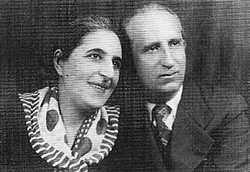
Tzemach Feldstein and his wife Fania
Family
His eldest son, Dr. Lev (Liova) Feldstein, began his medical studies at the University of Nancy, in France, and finished as an MD at the University of Lithuania in Kovno (Kaunas). At a fairly young age, Dr. Lev Feldstein became a renowned surgeon in Kaunas, Lithuania. He married Sara, the youngest daughter of Esther Aronovsky, a successful business woman. They both perished in the holocaust.[14] Their only daughter, Dr. Ada Levner, was saved by Catholic nurses who worked as housekeepers for the family who raised her. Later, she became a doctor like her father. Dr. Levner later immigrated to Israel from the Soviet Union, and since the 1990’s, lives in Canada.[15]
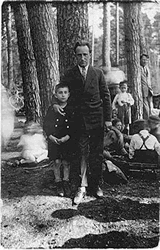
Tzemach Feldstein with his son Joshua on a Lag B’Omer Trip to Kulautuva in 1928
His daughter, Esther (Toussia), studied Economics in London. She married (Ika) Gilar Scheinberg, an engineer. Her husband served as a representative of Belgium in the Dutch East Indies. In the 1930s, Esther accompanied her husband to Medan, Sumatra (now Indonesia) where he built roads. In World War II, when the Japanese occupied the East Indies she became a political prisoner in the POW camp, Makassar, on the island of Celebes (now known as Sulawesi) (1942-1945). After the war, she divorced her husband, Gilar, and lived in Brussels. Two years later, she married Jean Loontjens, a Belgian businessman. Her health was in decline from years in the camp and she died on October 19, 1959, at the age of 65.
His youngest son, Yehoshua Feldstein (Professor Joshua Feldstein), graduated from the Hebrew Reali Gymnasium in 1938. A year later, he began his studies at the School of Engineering at the University of Lithuania and, a year after that; he went to the United States to study agricultural science at the Delaware Valley College in Doylestown, Pennsylvania. It was there that he began his academic career, later becoming president of the College.
Esther, (Essie) who was the granddaughter of Dr. Feldstein’s wife’s sister, became an American Jewish author by the name of Esther Hautzig. She was the wife of Walter Hautzig, an internationally known concert pianist.
Further reading
Hautzig, E. (2000) Ada and Eddy, in Remember Who You Are: Stories About Being Jewish, 1st paperback edition, Philadelphia, PA: Jewish Publication Society pp. 47–55.
External links
"Photos of Dr. Tzemach Feldstein". , headmaster of the Hebrew Realgymnasium in Kaunas (1922-1940).
Raskas, D.H. (prepared for press) (1997) "To the Minute: Dr. Tzemach Feldstein . Editorial in the Vilna Ghetto, 1942-1943". YIVO Newspaper New Series, Volume 3 (pp. 115–206. "Hebrew Books". (Yiddish)
References
1. Jump up ^ Yozelit, P. J. (1977). The Honored Past, Dr. Tzemach Feldstein, Exact dates of birth and death: Birth (p. 280). out-of-print. or on the Eilat Gordin Levitan website, "List of Teacher Job Applications in Krovno, 1921-1941". ; Record of death on the "List of the persecuted who perished in Dautmergen-Schömberg". , Central Database of the Holocaust, Victims names, Yad Vashem website.
2. Jump up ^ Feldstein, T. B. Z. z"l (1967). People. In: Dov Lipetz (Central Editorial Board), Natan Goren [Eds.], and The Association of The Lithuanian Jews in Israel, Lithuanian Jewry, Volume III (Book I) (p.210 column 2). Tel Aviv: Am HaSefer, or on the Eilat Gordin Levitan website, "List of Teacher Job Applications in Krovno, 1921-1941".
3. ^ Mendelssohn – Miskotz, M. J. (1972). Hebrew Gymnasia Vilkaviskis. In Dov Lipetz (Central Editorial Board), Natan Goren [Eds.], [and others]: Lithuanian Jewry, Volume II, (p.151.) Tel Aviv: Am HaSefer, or the Book of Remembrance of the Lithuanian Community (photo 873), in the New York Public Library
4. ^ Yozelit, P. J. (1977). Dr. Tzemach Feldstein, The Honored Past, (pp. 280-282). out-of-print
5. ^ Yozelit, P. J. (1977). According to Dr. Tzemach Feldstein, The Honored Past, (pp. 280-282). out-of-print. He said "Overnight a request and demand effect became an actually ringing of the Hebrew language in all the streets of Kovno by gymnasia students. Interestingly, when Ussishkin visited Lithuania, in the 1920’s, and walked the streets of Kovno, he said: Is this Krovno of Lithuania? No! This is Krovno of Tel Aviv...” p. 282.
6. ^ Klausner, J. (1947). Shaul Tschernikowsky: The Man and the Poet, [Hebrew] (In memory of Sir Montague Burton,) Jerusalem: The Hebrew Foundation & The Hebrew University Press Association, p 190. or Shaanan, A. (1984). Shaul Tschernikowsky: A monograph, [Hebrew] Tel Aviv: Kibbutz Hameuchad, p. 246.
7. Jump up ^ Cohen, B. (1991). Hebrew Education in Independent Lithuania, Jewish Cities, Towns, and Rural Settlements in Lithuania until 1918: Historical - geographical sketch New York: p.743. also reprinted in: Zvi Sharfstein (ed.), (1957). Hebrew Education and Culture in Europe between the Two World Wars New York: Ogen Publishing, p.168
8. Jump up ^ Yozelit, P. J. (1977). The Honored Past, Dr. Tzemach Feldstein, (p.282). out-of-print
9. Jump up ^ Dvorzhetski, M. (1951). Jerusalem of Lithuania in Resistance and in the Holocaust, translated from Yiddish by Chaim Shalom Ben Avraham; A few chapters were written in Hebrew by the author, Tel Aviv: Mifleget Poalei Eretz Yisrael, (lit. "Workers' Party of the Land of Israel), p. 240.
10. ^ Dvorzhetski, M.(2007). Spiritual life in the Vilna Ghetto, Journal Forum commemorating the Holocaust 18: The spirit of the Jewish man in the Holocaust. (27, 35 39, 41-42).
11. ^ Kaplan, I. (1984) Deportations to Latvia and to Estonia. In: Dov Lipetz (Central Editorial Board), Natan Goren [Eds.], and The Association of The Lithuanian Jews in Israel, Lithuanian Jewry, Volume IV: The Holocaust 1941-1945. Tel Aviv: Am HaSefer, p.385
12. ^ Entry on the "List of the persecuted who perished in Dautmergen-Schömberg". , Central Database of the Holocaust, Victims names, Yad Vashem website
13. Jump up ^ Feldstein, J. (2008). Dr. Tzemach Feldstein: Educator: Director Hebrew Reale Gymnasia Kovno, Lithuania. Gahelet, (March 2008) p. 55.
14. ^ "Lev Feldstein". ,"Sara Feldstein (nee Aronovsky)". : Based pages of testimony submitted by their daughter, Ada Levner, Central Database of Holocaust Victims' Names of Krovno, Yad Vashem website
15. Feldstein-Levner, A. (2011). 'The Prayer of an Innocent Girl,' in: Smuggled in Potato Sacks: Fifty Stories of the Hidden Children of the Kaunas Ghetto, S. Abramovich and Y. Zilberg (eds.), London: Valentine Mitchell, pp. 215-218.
Janet Satler Luterman thank you for alerting me.
